So far, this section has dealt with chickens, chickens
and more chickens. There are of course other birds that fit under the classification of
"barnyard."
Next to chickens, ducks would be without doubt the most popular bird in backyards and
on farms. This article gets down to the nitty-gritty about popular duck breeds and what
they are used for. So let's take a quick view of the more common breeds of duck found
around the world.
 Most ducks are descended from the wild Mallard. Over
years of careful selection, most of these breeds have lost the ability (or inclination) to
fly, quite unlike their wild cousins.
Most ducks are descended from the wild Mallard. Over
years of careful selection, most of these breeds have lost the ability (or inclination) to
fly, quite unlike their wild cousins.
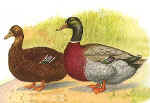 The Rouen is a French breed (hence the name) which has retained
the same colour pattern of the Mallard. It is a large duck, being bred for the lucrative
meat trade, with a deep, square keel (or breast-bone). It is not a quick growing duck, nor
is it a particularly good layer. The Aylesbury is another deep-keeled duck, but is snow
white in colour and not quite as large as the Rouen. It originates from Britain and is
also a meat breed.
The Rouen is a French breed (hence the name) which has retained
the same colour pattern of the Mallard. It is a large duck, being bred for the lucrative
meat trade, with a deep, square keel (or breast-bone). It is not a quick growing duck, nor
is it a particularly good layer. The Aylesbury is another deep-keeled duck, but is snow
white in colour and not quite as large as the Rouen. It originates from Britain and is
also a meat breed.
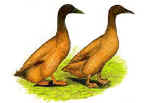 The Campbell breed comes in a variety of colours of
which the Khaki is the most popular and commonly seen. It is a medium sized duck, which
has a similar plumage pattern to the Mallard, but with different colouring. It is bred
primarily as a dual-purpose duck, being both a good layer and a meat bird.
The Campbell breed comes in a variety of colours of
which the Khaki is the most popular and commonly seen. It is a medium sized duck, which
has a similar plumage pattern to the Mallard, but with different colouring. It is bred
primarily as a dual-purpose duck, being both a good layer and a meat bird.
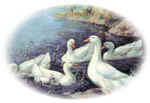 The Pekin is a large creamy-white duck, with plumage which
carries a peculiar canary colouring. It has an upright stance with the legs set right back
on its body. It is another dual-purpose breed. The Pekin is believed to have originated
somewhere in Asia and came to the west in the middle 1800s.
The Pekin is a large creamy-white duck, with plumage which
carries a peculiar canary colouring. It has an upright stance with the legs set right back
on its body. It is another dual-purpose breed. The Pekin is believed to have originated
somewhere in Asia and came to the west in the middle 1800s.
 The Cayuga is a glossy black breed originating in America. Though
modern Cayugas are quite large birds with rich beetle-green sheen, the early type was
small with little keel, with more dusky colouring. It is a quiet, docile duck which is
both a good layer and fine meat bird. The Cayuga tends to stick close to its home
territory which makes it ideal for smaller areas.
The Cayuga is a glossy black breed originating in America. Though
modern Cayugas are quite large birds with rich beetle-green sheen, the early type was
small with little keel, with more dusky colouring. It is a quiet, docile duck which is
both a good layer and fine meat bird. The Cayuga tends to stick close to its home
territory which makes it ideal for smaller areas.
 The Orpington originated in Britain and was the
brainchild of William Cook, who also developed the Orpington fowl. It comes in two
colours, buff and blue, and is mostly bred for laying. The orpington matures early and is
an excellent forager on more open range.
The Orpington originated in Britain and was the
brainchild of William Cook, who also developed the Orpington fowl. It comes in two
colours, buff and blue, and is mostly bred for laying. The orpington matures early and is
an excellent forager on more open range.
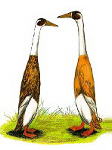 The Indian Runner is a strange-looking bird, very
upright and slender of build. It is a small bird and is an extremely good layer, being
bred for that purpose. It is a very active and wide-roaming duck. It is popularly kept in
backyards, where it forages actively, eating all sorts of pests, particularly snails.
The Indian Runner is a strange-looking bird, very
upright and slender of build. It is a small bird and is an extremely good layer, being
bred for that purpose. It is a very active and wide-roaming duck. It is popularly kept in
backyards, where it forages actively, eating all sorts of pests, particularly snails.
 The Muscovy is a very different breed, originating in South
America. It bears no similarity to other breeds of ducks, either in type, size or colour.
The drakes are extremely large, sometimes 12 pounds or more in weight, yet the females are
only about half that size. The drakes are very aggressive and will fight amongst
themselves as well as attack other ducks and poultry.
The Muscovy is a very different breed, originating in South
America. It bears no similarity to other breeds of ducks, either in type, size or colour.
The drakes are extremely large, sometimes 12 pounds or more in weight, yet the females are
only about half that size. The drakes are very aggressive and will fight amongst
themselves as well as attack other ducks and poultry.
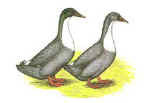 Other breeds of ducks less commonly seen include the Crested,
Blue Swedish, Appleyard, Harlequin and Call.
Other breeds of ducks less commonly seen include the Crested,
Blue Swedish, Appleyard, Harlequin and Call.
 Most ducks are descended from the wild Mallard. Over
years of careful selection, most of these breeds have lost the ability (or inclination) to
fly, quite unlike their wild cousins.
Most ducks are descended from the wild Mallard. Over
years of careful selection, most of these breeds have lost the ability (or inclination) to
fly, quite unlike their wild cousins.  The Rouen is a French breed (hence the name) which has retained
the same colour pattern of the Mallard. It is a large duck, being bred for the lucrative
meat trade, with a deep, square keel (or breast-bone). It is not a quick growing duck, nor
is it a particularly good layer. The Aylesbury is another deep-keeled duck, but is snow
white in colour and not quite as large as the Rouen. It originates from Britain and is
also a meat breed.
The Rouen is a French breed (hence the name) which has retained
the same colour pattern of the Mallard. It is a large duck, being bred for the lucrative
meat trade, with a deep, square keel (or breast-bone). It is not a quick growing duck, nor
is it a particularly good layer. The Aylesbury is another deep-keeled duck, but is snow
white in colour and not quite as large as the Rouen. It originates from Britain and is
also a meat breed.  The Campbell breed comes in a variety of colours of
which the Khaki is the most popular and commonly seen. It is a medium sized duck, which
has a similar plumage pattern to the Mallard, but with different colouring. It is bred
primarily as a dual-purpose duck, being both a good layer and a meat bird.
The Campbell breed comes in a variety of colours of
which the Khaki is the most popular and commonly seen. It is a medium sized duck, which
has a similar plumage pattern to the Mallard, but with different colouring. It is bred
primarily as a dual-purpose duck, being both a good layer and a meat bird.  The Pekin is a large creamy-white duck, with plumage which
carries a peculiar canary colouring. It has an upright stance with the legs set right back
on its body. It is another dual-purpose breed. The Pekin is believed to have originated
somewhere in Asia and came to the west in the middle 1800s.
The Pekin is a large creamy-white duck, with plumage which
carries a peculiar canary colouring. It has an upright stance with the legs set right back
on its body. It is another dual-purpose breed. The Pekin is believed to have originated
somewhere in Asia and came to the west in the middle 1800s.  The Cayuga is a glossy black breed originating in America. Though
modern Cayugas are quite large birds with rich beetle-green sheen, the early type was
small with little keel, with more dusky colouring. It is a quiet, docile duck which is
both a good layer and fine meat bird. The Cayuga tends to stick close to its home
territory which makes it ideal for smaller areas.
The Cayuga is a glossy black breed originating in America. Though
modern Cayugas are quite large birds with rich beetle-green sheen, the early type was
small with little keel, with more dusky colouring. It is a quiet, docile duck which is
both a good layer and fine meat bird. The Cayuga tends to stick close to its home
territory which makes it ideal for smaller areas.  The Orpington originated in Britain and was the
brainchild of William Cook, who also developed the Orpington fowl. It comes in two
colours, buff and blue, and is mostly bred for laying. The orpington matures early and is
an excellent forager on more open range.
The Orpington originated in Britain and was the
brainchild of William Cook, who also developed the Orpington fowl. It comes in two
colours, buff and blue, and is mostly bred for laying. The orpington matures early and is
an excellent forager on more open range.  The Indian Runner is a strange-looking bird, very
upright and slender of build. It is a small bird and is an extremely good layer, being
bred for that purpose. It is a very active and wide-roaming duck. It is popularly kept in
backyards, where it forages actively, eating all sorts of pests, particularly snails.
The Indian Runner is a strange-looking bird, very
upright and slender of build. It is a small bird and is an extremely good layer, being
bred for that purpose. It is a very active and wide-roaming duck. It is popularly kept in
backyards, where it forages actively, eating all sorts of pests, particularly snails.  The Muscovy is a very different breed, originating in South
America. It bears no similarity to other breeds of ducks, either in type, size or colour.
The drakes are extremely large, sometimes 12 pounds or more in weight, yet the females are
only about half that size. The drakes are very aggressive and will fight amongst
themselves as well as attack other ducks and poultry.
The Muscovy is a very different breed, originating in South
America. It bears no similarity to other breeds of ducks, either in type, size or colour.
The drakes are extremely large, sometimes 12 pounds or more in weight, yet the females are
only about half that size. The drakes are very aggressive and will fight amongst
themselves as well as attack other ducks and poultry.  Other breeds of ducks less commonly seen include the Crested,
Blue Swedish, Appleyard, Harlequin and Call.
Other breeds of ducks less commonly seen include the Crested,
Blue Swedish, Appleyard, Harlequin and Call.